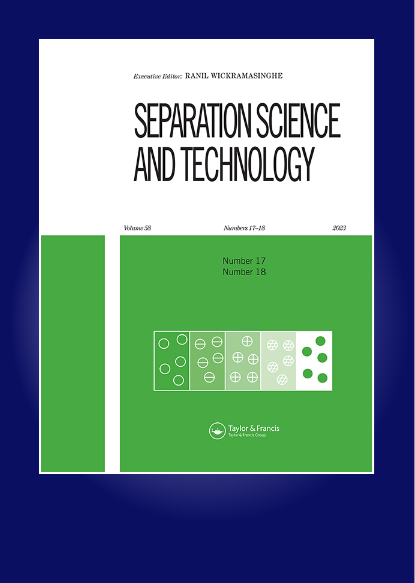Aminated cellulose-GO-Doped manganese ferrite Nanosorbent with Enhanced adsorption properties of Diclofenac: Isotherm, kinetic, and Thermodynamic Study
IF 2.3
4区 工程技术
Q3 CHEMISTRY, MULTIDISCIPLINARY
引用次数: 0
Abstract
ABSTRACT Biomagnifications of emergent contamination with diclofenac in aquatic media exert adverse effects on ecosystems and the environment. Hence, employing an effective remediation route, especially magnetic adsorption, is highly beneficial to eliminating hazardous pharmaceutical wastes. In this research, an efficient magnetic nanoadsorbent derived from aminated manganese ferrite, cellulose, and graphene oxide (GO) has been characterized and employed for diclofenac (DF) removal. Results of EDX analysis showed that aminopropyltriethoxysilane, as an amine source, have been anchored on the magnetic adsorbent surface with high density. Moreover, FESEM and TEM images, as well as the XRD pattern, confirmed that the nanocomposite is a three-component adsorbent. Response surface methodology was adopted to optimize effective parameters for DF adsorption. Solution pH, contact time, adsorbent amount, and concentration of NaNO3 were four variables that have been optimized. Kinetic and isotherm studies for the adsorption experiments showed that diclofenac adsorption followed the pseudo-second-order kinetic model and Langmuir adsorption isotherm. Moreover, the thermodynamic study indicated that the adsorption process is spontaneous and follows an exothermic path. With a high maximum adsorption capacity of 439.0 mg.g−1 and an adequate removal efficiency of 98.0%, the aminated MnFe2O4-cellulose-GO is a suitable candidate to mitigate the side effects of DF in aqueous media.具有增强双氯芬酸吸附特性的掺锰铁氧体纤维素纳米吸附剂:等温线、动力学和热力学研究
摘要 双氯芬酸在水生介质中的生物放大污染对生态系统和环境造成了不利影响。因此,采用有效的修复途径,特别是磁性吸附,对消除有害医药废物大有裨益。在这项研究中,对一种由氨基化锰铁氧体、纤维素和氧化石墨烯(GO)衍生的高效磁性纳米吸附剂进行了表征,并将其用于去除双氯芬酸(DF)。乙二胺四乙酸氧化物分析结果表明,作为胺源的氨丙基三乙氧基硅烷以高密度锚定在磁性吸附剂表面。此外,FESEM 和 TEM 图像以及 XRD 图样也证实该纳米复合材料是一种三组分吸附剂。采用响应面方法优化了 DF 吸附的有效参数。对溶液 pH 值、接触时间、吸附剂用量和 NaNO3 浓度这四个变量进行了优化。吸附实验的动力学和等温线研究表明,双氯芬酸的吸附遵循假二阶动力学模型和 Langmuir 吸附等温线。此外,热力学研究表明,吸附过程是自发的,并遵循放热路径。胺化 MnFe2O4-纤维素-GO 的最大吸附容量高达 439.0 mg.g-1,去除效率高达 98.0%,因此是减轻水介质中 DF 副作用的合适候选材料。
本文章由计算机程序翻译,如有差异,请以英文原文为准。
求助全文
约1分钟内获得全文
求助全文
来源期刊

Separation Science and Technology
工程技术-工程:化工
CiteScore
6.10
自引率
3.60%
发文量
131
审稿时长
5.7 months
期刊介绍:
This international journal deals with fundamental and applied aspects of separation processes related to a number of fields. A wide range of topics are covered in the journal including adsorption, membranes, extraction, distillation, absorption, centrifugation, crystallization, precipitation, reactive separations, hybrid processes, continuous separations, carbon capture, flocculation and magnetic separations. The journal focuses on state of the art preparative separations and theoretical contributions to the field of separation science. Applications include environmental, energy, water, and biotechnology. The journal does not publish analytical separation papers unless they contain new fundamental contributions to the field of separation science.
 求助内容:
求助内容: 应助结果提醒方式:
应助结果提醒方式:


